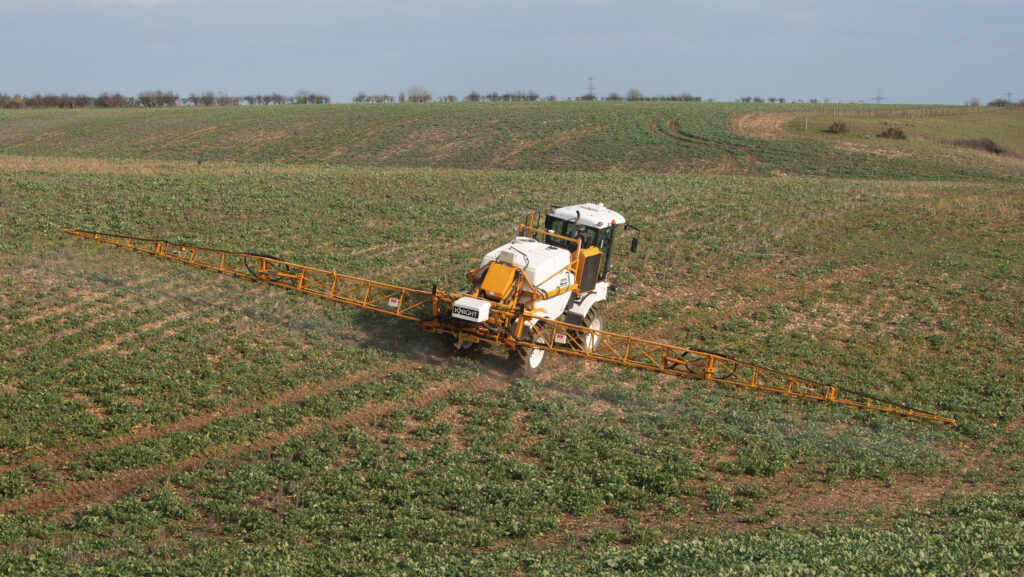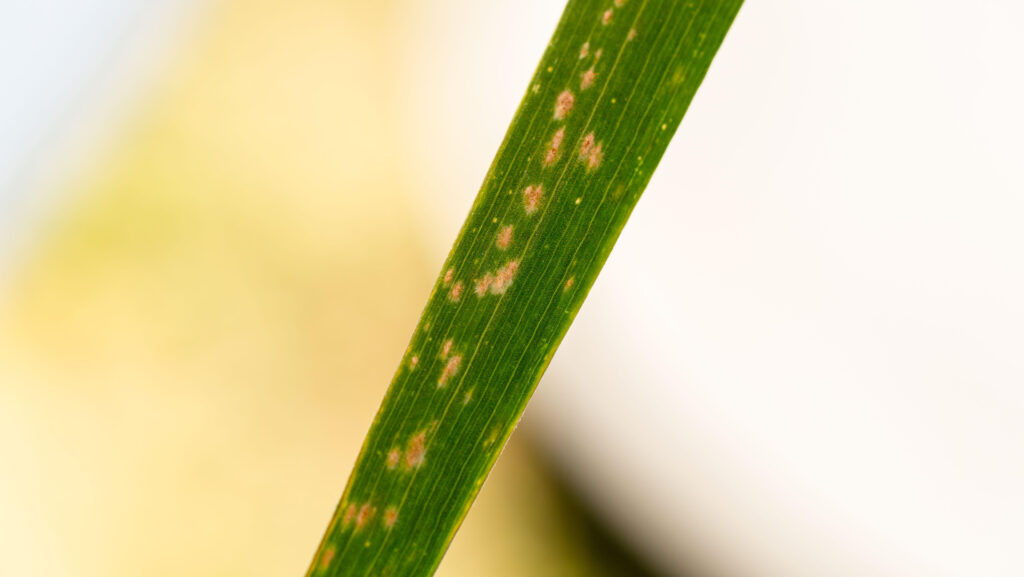Crop Watch: Still too warm for propyzamide sprays in bonfire week
 © Tim Scrivener
© Tim Scrivener Aphids continue to be found in cereal crops as the mild conditions continue, while some forward crops of barley are showing signs of mildew.
Bonfire night tends to be around the time that soils are becoming cold enough for propyzamide applications to oilseed rape, but this isn’t a normal autumn and patience may be needed.
See also: How UK potato harvest has fared in a challenging 2025 season
West
Will Spurdens, Ceres Rural (Shropshire and Cheshire)
Surprisingly, I am not eating my words yet and it has been a kind four weeks since I last wrote. I believe we are all drilled up in the region, and even the most tricky of field corners has a crop growing in it.
Apart from the odd day, it has been a mild period leading to excellent growth, but also bringing a few more unwelcome friends (aphids) which have been easy to find in most cereal crops I am walking.
We are able to treat for these with a pyrethroid spray once the T-sum 170 day degrees has been reached and aphids are easy to find in the field. However, be mindful that pyrethroid sprays are not selective and will affect all beneficial insects in the field as well.
Due to the warm conditions, mildew has been seen in the past week in the more forward barley crops, and treatment may be required.

© Olga Seyfutdinova/Alamy Stock Photo
Follow-up post-emergence herbicides for awkward grassweeds have also been applied where appropriate, consisting of either a metribuzin or cinmethylin-based product with both having some contact activity on the newly emerging grassweeds.
Again, slugs are rarely being seen in the region and it has only been necessary to apply pellets on some heavier blocks following oilseed rape, but still the crops are managing to grow beyond the risk of too much slug grazing damage.
Broad-leaved weeds
This autumn has also allowed me to tidy up some more slightly messy fields with broad-leaved weeds actively growing following a legume fallow option. The active of choice has been a florasulam, plus or minus fluroxypyr to take out some rather obscure weeds following the legume fallow crops.
Should the effectiveness of herbicides be tested for these more rare weeds if these SFI actions continue?
Winter beans have been drilled and pre-emergence herbicides applied in good order.
Finally, oilseed rape has now all reached a growth stage where I am happy it should survive even a very harsh winter, and we will now plan for our later grass and broad-leaved weed control when temperatures drop.
This will generally be based on a propyzamide-type programme including some prothioconazole for phoma and light leaf spot suppression.
Once these last few jobs have been completed, it would be nice to see a cold winter to tackle some of the emerging disease and pest pressures in crops, but we will have to wait and see.
South
Justin Smith, Procam (East Sussex)
The rain has started to fall in Sussex, but the difference in progress and crop establishment compared with many recent autumns is staggering.
Most cereals have established evenly and are readily approaching growth stage 12-13. The continuing mild conditions are allowing aphids to multiply freely, and they can be found with relative ease.
An application of Clayton Lanark (lambda-cyhalothrin) is being used, alongside any additional residual herbicide top-ups and nutrition products, such as manganese, that may be required.
Growers place a lot of faith in us as agronomists to get the expenditure and financial balances of crops right, and this year will be as important as ever.
Often the results don’t just come from a chemical can, but an integrated approach and a relationship built on communication, transparency and trust; one that can encourage hard-hitting conversations to be had.
A diverse and sustainable cropping rotation can often outweigh a short-term decision based on either a reaction to a volatile market or the lure of a promising cash injection.
Hybrid barley
For example, despite the financials of winter feed barley, hybrid barley can remain a sensible investment where you are battling historic grassweed problems. I
ts early spring vigour and highly competitive nature can often lead to a suppression of subsequent late grassweed flushes, which can often be on par with any late-season herbicide effect.
Following this with winter oilseed rape can then often allow a spread of risk and workloads from its early establishment window, as well as permitting different herbicide modes of actions to be used to further combat troublesome weed pressures.
Both these crops have received bad press in recent years, from pest issues surrounding winter oilseed rape’s establishment to the current low prices being paid for feed winter barley. Despite this, though, they may remain the best option for a given farm.
For any business to survive, it often must adapt and change. In arable farming this can be as simple as a change of cultivation technique or rotation.
However, it is important to not let any changes be at the possible expense of the long-term business success.
North
Mary Munro, Munro Agricultural Consultancy (E Lothian)
The markets have dictated cropping plans more than usual this autumn, and there are a lot more fields of wheat than were originally planned.
The malting barley market turned tricky and, although wheat prices are not wildly inspiring, many growers have reduced their barley acreage in favour of the greater margins achievable with wheat. Weather conditions made this an easy swap.
Potatoes have all been lifted and wheat drilled behind them, which is not always achievable.
It has been a joy to walk wheat crops without significant slug damage this season, and the later-sown fields have emerged evenly. Virtually everything has been rolled and sprayed with herbicide, tasks are complete and crops are looking very well.
Oilseed rape crops have rallied after a bit of pressure from beetles and are growing steadily. Temperatures are beginning to drop, but it has not been cold enough for Kerb (propyzamide) so far.
Soil testing
I have been encouraging farmers to make use of the Scottish Government Rural Payments and Inspections Directorate grant towards soil analysis to check the pH, P, K, Mg and soil carbon levels, and get the claim in before the end of the year.
It is good to see some high organic matter levels (well above 5%) on the mineral soils of East Lothian, reflecting the amount of straw incorporation and use of manures and composts.
It is a slow job to improve soil organic matter, but it makes such a difference to the ability to drain and retain moisture, and to get onto the land without damaging structure. Resilience in the true meaning of the word – and better soil biology as well.
I have various meetings to organise this month and one of the most interesting is the arable crop benchmarking group.
These groups always have great discussions and a good bit of banter. We will be looking at the 2025 harvest year, and it will certainly be a more upbeat meeting than the 2024 figures produced.
The prospects for 2026 are harder to read – the gross margins may be much the same, but fixed costs could be all over the place as businesses grapple with the costs of labour and machinery, insurance and tax.
East
Rory Kissock, Farmacy (Essex, Herts, Cambs and Suffolk)
In farming we often say no two years are the same – but the drilling conditions in the past week have been fantastic and are very similar to this time last year. Some have even had the rolls out. The most important thing to consider when drilling is delayed into November is ensuring that the seed rate used is sufficient.
Benchmark figures suggest that we should be targeting 260 plants/sq m established in the spring.
To achieve this, we need to drill enough seeds/sq m to allow for lower establishment – the later we drill increases over-winter losses due to smaller/weaker plants.
Establishment rates from September through to the end of October can range from 80% down to 60%. From November onwards it can be as low as 50%, requiring 400-500 seeds/sq m in the worst cases.
Now is a good time to get out and do some plant counts – it is always easier before any tillers emerge.
This is a good assessment to check establishment percentage and if the seed rates used are correct or if they may need tweaking in future.
The use of Vibrance Duo (fludioxonil + sedaxane) seed treatment can also benefit in the later drilling period to help increase plant development.
BYDV spray
Earlier drilled wheat crops will be getting a barley yellow dwarf virus (BYDV) treatment when the T-sum 170 threshold is accumulated.
Where necessary, residual herbicide top-ups will be going onto target areas or high pressure fields. Make sure you know the growth stage cut-off associated with the actives being used, and consider the weather that could well follow.
Oilseed rape crops are benefiting from the warmer-than-normal weather and the recent rains.
This has been particularly helpful to the later-drilled crops which are now covering the ground.
Propyzamide timing is on the horizon, but soil temperatures need to be 10C and falling, with sufficient moisture. Bonfire night is normally around the time when conditions are right.
The Corteva app has a useful Kerb timing tool. You can locate your fields and it will then monitor conditions and tell you when it is right to go.
Stewardship around the propyzamide molecule is very important, as it’s a vital tool in the OSR herbicide armoury.
Sugar beet lifting is well under way now, with beet coming out in near-perfect conditions and wheat being tucked in behind.
I am pleased to say that yields aren’t as bad as expected, considering the season, and sugar levels are remaining high.

